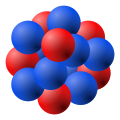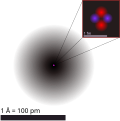Atomic nucleus
Atomic Nucleus
The atomic nucleus is the small, dense region consisting of protons and neutrons at the center of an atom. Discovered in 1911 by Ernest Rutherford, the atomic nucleus is held together by the strong force, one of the four fundamental forces of nature.
Structure[edit]
The atomic nucleus is composed of two kinds of particles: protons and neutrons, collectively known as nucleons. Protons carry a positive electric charge, while neutrons are electrically neutral. The number of protons in the nucleus determines the atomic number and identifies the chemical element. The total number of protons and neutrons in the nucleus defines an atom's mass number.
Properties[edit]
The atomic nucleus is extremely dense and accounts for nearly all the mass of an atom. Despite its small size, the nucleus contains over 99.9% of an atom's mass but occupies only about one ten-thousandth of the total volume of the atom.
Nuclear Forces[edit]
The atomic nucleus is held together by the strong force, which overcomes the electromagnetic force that would otherwise cause the positively charged protons to repel each other. The strong force binds protons and neutrons together in the nucleus.
Nuclear Reactions[edit]
Changes in the atomic nucleus can result in nuclear reactions, including nuclear fission, in which a nucleus splits into two or more smaller nuclei, and nuclear fusion, in which two or more smaller nuclei combine to form a larger nucleus. These reactions release a large amount of energy, which is the basis for nuclear power and nuclear weapons.
See Also[edit]
References[edit]
<references />
-
Diagram of an atomic nucleus
-
Quantum mechanical model of a helium atom
-
Liquid drop model of the atomic nucleus
Ad. Transform your life with W8MD's Budget GLP-1 injections from $75


W8MD offers a medical weight loss program to lose weight in Philadelphia. Our physician-supervised medical weight loss provides:
- Weight loss injections in NYC (generic and brand names):
- Zepbound / Mounjaro, Wegovy / Ozempic, Saxenda
- Most insurances accepted or discounted self-pay rates. We will obtain insurance prior authorizations if needed.
- Generic GLP1 weight loss injections from $75 for the starting dose.
- Also offer prescription weight loss medications including Phentermine, Qsymia, Diethylpropion, Contrave etc.
NYC weight loss doctor appointmentsNYC weight loss doctor appointments
Start your NYC weight loss journey today at our NYC medical weight loss and Philadelphia medical weight loss clinics.
- Call 718-946-5500 to lose weight in NYC or for medical weight loss in Philadelphia 215-676-2334.
- Tags:NYC medical weight loss, Philadelphia lose weight Zepbound NYC, Budget GLP1 weight loss injections, Wegovy Philadelphia, Wegovy NYC, Philadelphia medical weight loss, Brookly weight loss and Wegovy NYC
|
WikiMD's Wellness Encyclopedia |
| Let Food Be Thy Medicine Medicine Thy Food - Hippocrates |
Medical Disclaimer: WikiMD is not a substitute for professional medical advice. The information on WikiMD is provided as an information resource only, may be incorrect, outdated or misleading, and is not to be used or relied on for any diagnostic or treatment purposes. Please consult your health care provider before making any healthcare decisions or for guidance about a specific medical condition. WikiMD expressly disclaims responsibility, and shall have no liability, for any damages, loss, injury, or liability whatsoever suffered as a result of your reliance on the information contained in this site. By visiting this site you agree to the foregoing terms and conditions, which may from time to time be changed or supplemented by WikiMD. If you do not agree to the foregoing terms and conditions, you should not enter or use this site. See full disclaimer.
Credits:Most images are courtesy of Wikimedia commons, and templates, categories Wikipedia, licensed under CC BY SA or similar.
Translate this page: - East Asian
中文,
日本,
한국어,
South Asian
हिन्दी,
தமிழ்,
తెలుగు,
Urdu,
ಕನ್ನಡ,
Southeast Asian
Indonesian,
Vietnamese,
Thai,
မြန်မာဘာသာ,
বাংলা
European
español,
Deutsch,
français,
Greek,
português do Brasil,
polski,
română,
русский,
Nederlands,
norsk,
svenska,
suomi,
Italian
Middle Eastern & African
عربى,
Turkish,
Persian,
Hebrew,
Afrikaans,
isiZulu,
Kiswahili,
Other
Bulgarian,
Hungarian,
Czech,
Swedish,
മലയാളം,
मराठी,
ਪੰਜਾਬੀ,
ગુજરાતી,
Portuguese,
Ukrainian


